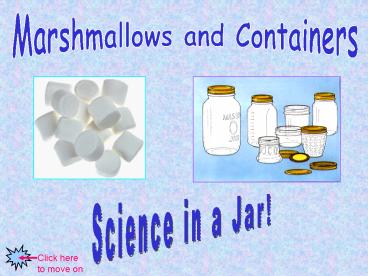Which can Hold the Most Marshmallows - PowerPoint PPT Presentation
1 / 16
Title:
Which can Hold the Most Marshmallows
Description:
Which container will hold the most marshmallows. Let's investigate! ... We can measure the volume of a container by counting the number of marshmallows ... – PowerPoint PPT presentation
Number of Views:44
Avg rating:3.0/5.0
Title: Which can Hold the Most Marshmallows
1
Marshmallows and Containers
Science in a Jar!
Click here to move on
2
Which container will hold the most marshmallows
Which has the greatest volume
Let's investigate!
3
But firstwhat is volume?
- Volume is the amount of space an object takes up.
Volume
- We can measure the volume of a container by
counting the number of marshmallows that fit
inside the container.
Let's try it!
4
Here are the things you need
- Miniature marshmallows
- 3 different size containers
- pencil
- 2 worksheets teacher will provide this
5
Step 1
Look at the 3 containers
2
1
3
Pick the one that you think would hold the most
marshmallows and click on it.
6
On worksheet A, put a check mark in the box
next to the container that you think will hold
the most marshmallows.
A Name _______ Which do you think will
hold more marshmallows? 1. 2.
3.
7
Step 2
- Go to the work table where the three containers
are set up. - With your group, fill each container up to the
rim with marshmallows. Count each marshmallow as
you put it in. - Do not pack the marshmallows in. Just drop the
marshmallows down in the container gently.
8
Step 3
- On Worksheet B, record in the boxes the number
of marshmallows that fit in each container.
B Name _______ How many marshmallows
fit in each container? 1. 2.
3.
9
Step 3
- Use your data from Worksheet B to make a bar
graph similar to this one.
1
2
3
Container
10
Step 4
- Look at your bar graph. Which container held the
most marshmallows? - Which container held the least marshmallows?
- Compare your graph to another groups graph.
Note any differences and/or similarities.
- Write your answers to these questions on the back
of Worksheet B.
11
More Questions
- Which container is the tallest? The shortest?
- Did the tallest container hold the most
marshmallows? - Which container has the greatest volume?
- Write your answers to these questions on the
back of Worksheet B.
12
What do you think?
- Will a taller container always have a bigger
volume than a shorter one? Why? - What would happen if we used large instead of
miniature marshmallows? - Can you think of another way to measure the
volume inside a container?
Record your answers.
13
A brief explanation
- Container 2 and 3 (jar and bowl) held more
marshmallows than container 1 (tall cylinder
vase) because they have a much greater width than
the tall cylinder vase. - The container that held the most marshmallows has
the greatest volume because the space inside that
container is largest and provided more space to
fit the marshmallows. - The volume of a space figure is the number of
cubic units the figure contains. In this
lesson, we used marshmallows as a unit of
measure.
14
Continued
- Variations in how the marshmallows were packed,
differences in how completely the containers were
filled, and errors in counting could all account
for the differences in data and graphs when
compared to others.
15
Now...enjoy some yummy, delicious marshmallows!
16
SOURCES
Isaacs, A.C., Kelso, C.R. (1996). Pictures,
tables, graphs, and questions Statistical
processes. Teaching Children Mathematics. 2(6)
340-345































